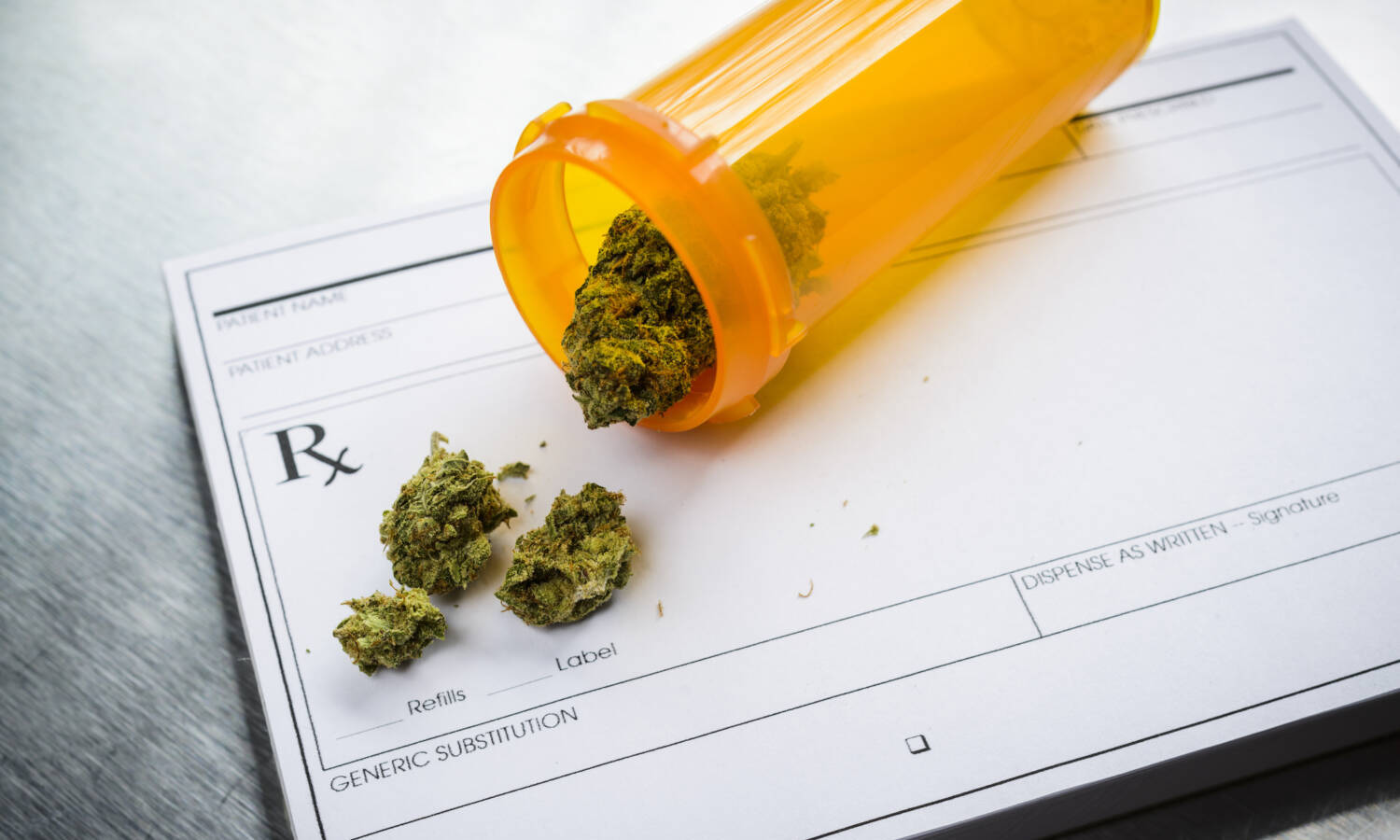
Which states will have medical marijuana in 2022?
This article originally appeared on Cannabis.net and has been republished with permission.
Now that the stigma surrounding cannabis is dissipating, more and more people are realizing that medical marijuana can help improve their quality of life. Most US states have initiated MMJ programs, but each has different qualification requirements, ownership limits, and home-growing regulations.
This article covers the basics for every state with legalized medical marijuana in 2022.
RELATED: Evaluating Each State’s Marijuana Program — How Well Did Your State Do?
Photo by traffic_analyzer/Getty Images
How to get a medical marijuana card in the US
In most states, obtaining a medical marijuana card involves the following:
- Obtaining a written recommendation from a doctor
- file application
- Payment of a non-refundable fee
The My Marijuana Cards association can help you find out how to get a medical marijuana card in your state and find a doctor who can recommend medical cannabis.
US states with medical marijuana programs
Alaska
Alaska legalized medical marijuana on November 4, 2014 and started its program in 2016.
- Conditions: Most chronic or debilitating diseases
- Limit: 1 ounce
- Own cultivation: 6 plants
Arizona
The Arizona state government passed Proposition 203 in 2010, legalizing medical marijuana. Arizona opened its recreational market in January 2022.
- Conditions: Most chronic or debilitating diseases.
- Limit: 2.5 ounces
- Self-cultivation: Only for patients who live more than 40 km from a pharmacy.
Arkansas
Arkansas residents voted in favor of medical marijuana in 2016 and the law was changed in 2017.
- Medical Conditions: Debilitating medical conditions that have not responded to any other treatment for six months
- Limit: 2.5 ounces
- Self-cultivation: no
California
As the first state to legalize medical marijuana, California has allowed patients access to cannabis products since 1996.
Colorado
Colorado initiated its MMJ program in 2000 and was one of the first states to legalize recreational marijuana in 2012.
 Photo by Karolina Grabowska from Pexels
Photo by Karolina Grabowska from Pexels
Connecticut
In 2012, Connecticut became the 17th state to legalize medical marijuana.
- Diseases: A wide range of chronic diseases
- Limit: 3.5 ounces/month
- Own cultivation: 3 mature and 3 immature plants
Delaware
Delaware’s SB17 legalized medical marijuana in 2011.
- Conditions: cancer, AIDS, PTSD, cirrhosis; ALS, Alzheimer’s, cachexia, chronic pain and severe nausea, seizures or muscle spasms.
- Limit: 6 ounces
- Self-cultivation: no
Florida
Florida’s MMJ Legalization Initiative was passed in 2016.
- Conditions: As determined by a licensed physician
- Limit: 70-day supply
- Self-cultivation: no
Hawaii
Hawaii started its medicinal cannabis program in late 2000. In 2022, the state stopped requiring medical permits for patients over 65.
- Conditions: cachexia, cancer; Chron, chronic pain, seizures, glaucoma; HIV/AIDS, MS Multiple Sclerosis, Nausea and other conditions subject to federal approval.
- Limit: 4 ounces
- Own cultivation: 10 plants
Illinois
Illinois started its MMJ program in 2013 and became a legal recreational cannabis state in 2020.
- Conditions: As determined by the doctor; subject to government approval.
- Limit: 2.5 ounces
- Self-cultivation: no
Louisiana
Louisiana launched its limited medical cannabis program after the legislation passed in 2017.
- Conditions: cachexia, cancer; Crohn’s disease, epilepsy; HIV/AIDS, muscular dystrophy, multiple sclerosis, seizures, spasticity.
- Limit: 30-day supply of non-smokable products
- Self-cultivation: no
 Photo by Esther Kelleter/EyeEm/Getty Images
Photo by Esther Kelleter/EyeEm/Getty Images
Maine
Maine citizens have had access to medicinal cannabis since 1999.
- Medical Conditions: Seizures, Glaucoma, MS, Nausea, HIV/AIDS, Cancer, Hepatitis C, ALS, Crohn’s Disease, Alzheimer’s, Cachexia and other recognized diseases
- Limit: 2.5 ounces
- Own cultivation: 6 plants
Maryland
Eligible patients were granted access to Maryland’s MMJ program in 2013.
- Medical Conditions: Any serious medical condition where other treatments have been ineffective
- Limit: 120 grams
- Self-cultivation: no
Massachusetts
Massachusetts introduced its medical marijuana program in 2013.
- Conditions: As determined by the patient’s physician
- Limit: 10 ounces every two months
- Own cultivation: 12 flowering, 12 vegetative
Michigan
Michigan’s MMJ program started in 2008 and recreational cannabis sales began in 2018.
- Medical conditions: cancer, HIV/AIDS, hepatitis C, glaucoma, ALS, Crohn’s disease, epilepsy, MS, Alzheimer’s, nail patella, cachexia and severe pain, nausea, seizures or muscle spasms
- Limit: 2.5 ounces
- Own cultivation: 12 plants
Minnesota
Minnesota voters passed legislation legalizing MMJ in 2014.
- Medical conditions: ALS, cancer/cachexia, AIDS, glaucoma, seizures; severe and persistent muscle spasms, autism, sleep apnea and terminal illnesses
- Limit: 30-day supply; no tobacco products
- Self-cultivation: no
Mississippi
Mississippi began accepting applications for its MMJ program in 2022.
Missouri
Missouri voters passed medical marijuana legislation in 2018.
- Medical Conditions Covered: Chronic medical conditions as determined by a physician
- Limit: 4 ounces/month
- Own cultivation: 6 plants
Montana
Montana’s MMJ program began in 2008.
- Conditions: cachexia, chronic pain or nausea, epilepsy, MS, Crohn’s disease
- Limit: one ounce
- Own cultivation: 6 plants
 Photo by FangXiaNuo/Getty Images
Photo by FangXiaNuo/Getty Images
Nevada
Nevada approved MMJ in 2000 and became a legal recreational state in 2017.
- Conditions: HIV/AIDS, cancer; MS, epilepsy, glaucoma; cachexia; chronic nausea or pain and other state-approved conditions
- Limit: one ounce
- Own cultivation: 7 plants
New Hampshire
New Hampshire started its therapeutic cannabis program in 2013.
- Medical Conditions: Diseases and conditions that cause serious symptoms that cannabis can alleviate
- Limit: 2 ounces
- Self-cultivation: no
New Jersey
New Jersey began accepting applications for its MMJ program in 2011, and recreational sales will follow soon.
- Conditions: A wide range of serious and incurable diseases
- Limit: 2 ounces
- Self-cultivation: no
New Mexico
In 2007, New Mexico residents gained access to medicinal cannabis.
- Medical conditions: arthritis, chronic pain, neuropathy, nausea, cachexia, hepatitis, Crohn’s disease, PTSD, ALS, cancer; Glaucoma, MS, spinal cord injury, epilepsy, HIV/AIDS, terminal illness
- Limit: 6 ounces
- Homegrown: 16 total, 4 mature
new York
New York legalized medical marijuana in 2014 and became a legal recreational cannabis state in 2021.
- Conditions: As recommended by a doctor
- Limit: 3 ounces; 28 grams of concentrate
- Own cultivation: 6 plants
North Dakota
North Dakota passed the Compassionate Care Act in 2016.
- Conditions: On medical recommendation
- Limit: 3 ounces
- Self Grow: 8 plants if more than 40 miles from a dispensary
Ohio
Ohio’s MMJ program has been in existence since 2018.
- Conditions: As set by the State Medical Association
- Limit: 90 days supply
- Self-cultivation: no
Oklahoma
Oklahoma launched its medicinal cannabis program in 2018.
- Conditions: As determined by physician
- Limit: 8 ounces
- Own cultivation: 6 mature plants/ 6 seedlings
Oregon
Oregon followed California in introducing a medical marijuana program in 1998. The state became a recreational market in 2014.
- Conditions: Subject to government approval.
- Limit: 24 ounces
- Own cultivation: 6 mature, 18 seedlings
Pennsylvania
Pennsylvania legalized MMJ in April 2016.
RELATED: Should Workers’ Comp Cover Medical Marijuana? Feds weigh the growing problem
 Photo by Denise Hasse/EyeEm/Getty Images
Photo by Denise Hasse/EyeEm/Getty Images
Rhode Island
Rhode Island residents could apply for MMJ cards as of 2006.
- Diseases: epilepsy, MS, cancer, wasting syndrome, Crohn’s disease, Alzheimer’s disease, chronic pain
- Limit: 2.5 ounces
- Own cultivation: 12 plants
Utah
Utah initiated its MMJ program in 2018.
- Conditions: A wide range of diseases and conditions
- Limit: 2 ounces
- Home Grow: 6 plants for people 100+ miles from a pharmacy
Vermont
Vermont residents began applying to the MMJ program in 2004.
- Conditions: HIV/AIDS, cancer; MS, glaucoma; Multiple sclerosis, cachexia, chronic pain, PTSD, nausea, seizures, Crohn’s disease, Parkinson’s disease
- Limit: 2 ounces
- Homegrown: 2 mature, 7 immature
Washington
Measure 692 MMJ legalized in Washington State in 1998.
- Medical Conditions: Most chronic medical conditions with state approval
- Limit: 24 ounces
- Own cultivation: 15 plants
Washington, D.C
After an initial ban by city officials, residents of the nation’s capital were given access to medical marijuana in 2010.
- Conditions: Any condition that is “chronic or long-lasting; debilitating; serious medical condition treatable with marijuana
- Limit: 2 ounces
- Own cultivation: no
West Virginia
Registration for the MMJ program in West Virginia began in 2021.
- Conditions: terminal illness, cancer, ALS, PTSD, HIV/AIDS; AS; Parkinson’s, MS, spinal cord damage, epilepsy, neuropathy, Huntington’s, Crohn’s disease, seizures, sickle cell anemia or in certain cases chronic pain
- Limit: 30 days supply
- Self-cultivation: no
Virginia
Virginians got legal access to medicinal cannabis in 2020.
- Conditions: glaucoma, cancer and as determined by doctor
- Limit: one ounce
- Own cultivation: 4 plants
This article originally appeared on Cannabis.net and has been republished with permission.

Post a comment: